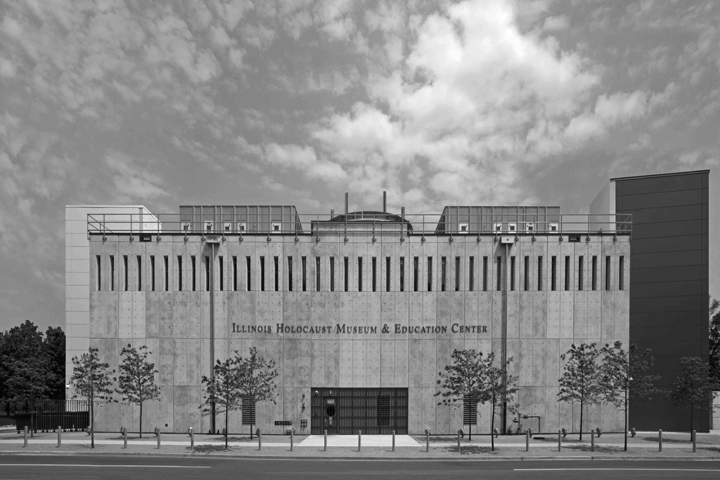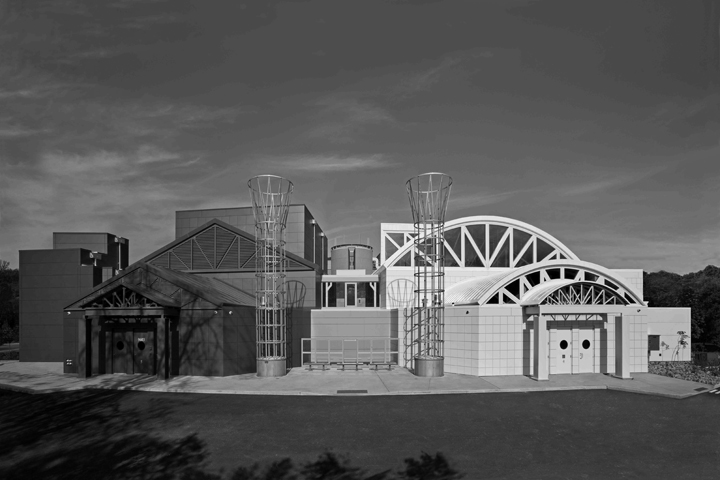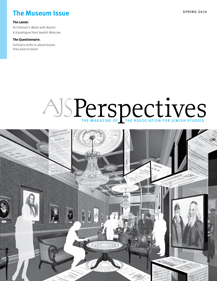
This museum is very much of its time—it resonates with the early twenty-first-century transformation in America's approach to memorializing the Holocaust. A placard near the entrance explains: "Dedicated to the survivors of the Holocaust, the building was designed in three parts. The dark section of the building suggests the Holocaust's descent into darkness. The cleave or hinge in the middle represents the rupture to humanity caused by the devastation. The sun-lit white section of the building represents the hope, enlightenment, and optimism of education and action." This sense of hope is felt phenomenologically as visitors move from dark to light. The center of the building houses a railcar with train tracks below. A dynamic tension thus stretches between the motion of dark to light and the motion of the train tracks leading to a room titled the Book of Remembrance. Names written in English, Hebrew, and Yiddish line the walls of this circular space; the letters begin small and dark and become progressively lighter and grayer as they ascend, giving the eerie impression of smoke rising into the two columns. The columns symbolize simultaneously a smoke stack and an ancient temple thus evoking the sacrificial and controversial element embedded in the word "Holocaust."

In the first part of the exhibit, the walls are constructed of thick, white streamlined bricks clearly designed to evoke Nazi architecture. The presence of dates inscribed thickly in the walls and accented further by a display case holding bright red Nazi armbands accompanied by an enormous photograph of a giant Nazi rally reinforces this sensation. This Nazi-architecture inflected area concludes with a large eagle, its talon clutching a Swastika, looming over a doorway. The eagle is surrounded by the passports (the actual passports) of Jewish citizens, affixed to the wall with Lucite and bearing the large red "J" that marked Jews. We enter this room through a portal, walking over broken glass (under a thick layer of solid glass) and view an impressive synagogue door, enlivened by an ever-changing film projected on it. The images projected onto the synagogue are of actual temples located all over Germany— Munich, Essen, Berlin, Baden Baden, Hanau, Aachen, Bamberg, and more. They are desecrated, graffitied, burnt, destroyed. In front of the synagogue there is a partially burnt Purim megillah saved by Jewish congregants during Kristallnacht (November 9–10, 1938), which further resonates with the broken glass embedded in the floor.
While the exhibit charts the history of the Holocaust we are reminded—much to the museum's credit—of the here and now. Images of contemporary Chicago including Anish Kapoor's Cloud Gate in Millennium Park (known as the silver "bean") are overlaid by the voices of survivors who note "It's always with us" or "My world was pretty much like yours, but then everything changed." These voices reinforce the idea that survivors must always live in the present alongside their traumatic past. They also underscore the idea that European Jews were free before the war and not living the stereotype of the ghetto Jew that has been so persistent and pervasive.
After moving through sections on the world's responses to the growing oppressions of the Nazi regime, complete with an image of Chamberlain signing the Munich pact in 1938, and another describing a "Mosaic of Victims" including political dissidents, Jehovah's Witnesses, Roma, homosexuals, and the physically and mentally disabled, the decor changes. We enter a recreated ghetto under a crude wooden fence that holds up a sign: "Wohngebiet JUDEN Betreten Verboten" (Jewish District. No entry.). Viewers thus "become" Jews for the brief time they remain in the "ghetto." Air raid sirens sound in the background as wall panels describe life in the Warsaw ghetto, where, in 1940, 400,000 Jews or 30 percent of Warsaw's population were compelled to live in 2.4 percent of the area of the city. One of the only spots of color in this room is a watercolor entitled Maryla Returns to School, painted by Nelly Toll while in hiding in Lvov in 1943 or 1944. Leaving the ghetto, visitors walk down a ramp and face a plaque bearing the title "Mass Murder" that begins a display about the Einsatzgruppen— the mobile killing units that were the harbingers of institutionalized genocide. The walls in this room are covered by one large photograph of an empty landscape punctuated solely by a video screen bearing pictures of dead bodies against that and similar landscapes through which the Einsatzgruppen moved. The contrast is very sharp—and effectively so, as the next room replicates the elegant Berlin villa, Wannsee, where, in January 1942 the details of the modern, mechanized genocide to come were planned.
The scene changes again as we enter a concrete room entitled "Deportation" where six television screens juxtapose images of deportation with the testimony of survivors. Turning a corner, a ramp leads to the railcar that forms the center of the museum; musty smelling and replete with a darkness meekly relieved by a few chinks in the old wood, the railcar is a space for visitors to imagine themselves in the shoes of deportees. Down another ramp, un-barbed wire and concrete walls have been embedded with blown-up, faded photographs of inmates in uniforms; an actual uniform, worn by Maurice Raichel and on loan from the Raichel family of Chicago, hangs in a vitrine. Under a plaque entitled "Auschwitz" is a vitrine containing a baby's faded leather shoe, a woman's shoe, and a cracked bowl—haunting and inexplicable remnants of genocide.
Moving through displays titled "Resistance" to "Liberation," one soldier remembers that some troops at liberation were repelled by what they saw and thus "vented their spleen by firing into the guards." In the next room, a replica of the Wailing Wall features two proud Israeli women of the early kibbutz era holding between them an Israeli flag. The final display bears the heading "Survivor Empowerment," and beneath it is a book in a case whose title could name the museum itself: From Holocaust to Redemption: Bearing Witness.
The exhibit ends with a film that describes the plans of the National Socialist Party of America (NSPA) to march on Skokie in 1977, a time when one out of every six Jewish residents was a survivor or a relation of a survivor. Despite the fact that the U.S. Supreme Court upheld the NSPA's right to march, a large parade never took place in Skokie. However, the threat to march was the impetus for the creation of the Holocaust Memorial Foundation of Illinois, which since 1981 has been spearheading the effort to build the Museum & Education Center. The film that closes the exhibit includes the story of the Rwandan genocide prefaced with this comment from a survivor: "The Holocaust is a Jewish story but genocide is worldwide." President Obama concurs by adding that "walls between races and tribes . . . cannot stand. These are the walls we must tear down!" As the film ends the words on the screen proclaim "Now it is up to you." This sense of being an engaged witness as a form of political action is underscored by the Miller Family Youth Exhibition, which has a very different tone than the rest of the museum. Here, bright colors predominate and children are encouraged via computer games to take a stand and make a difference—to cleave, in other words, to a moral center rather than to the dictates of bullies who stand in for dictators.
The impetus for the creation of this museum—and the decision to build it in Skokie—flowed from a rapid and powerful response to the threat of a neo-Nazi march through a Jewish neighborhood. The museum, then, can be seen as an intervention into the history of racism in America and as issuing a demand that witnessing no longer remain mute. The architecture of the museum and the structure of the exhibits unite in leading toward redemption, light, and out into the world, to other genocides and to a call for citizens to voice their intolerance of injustice.

